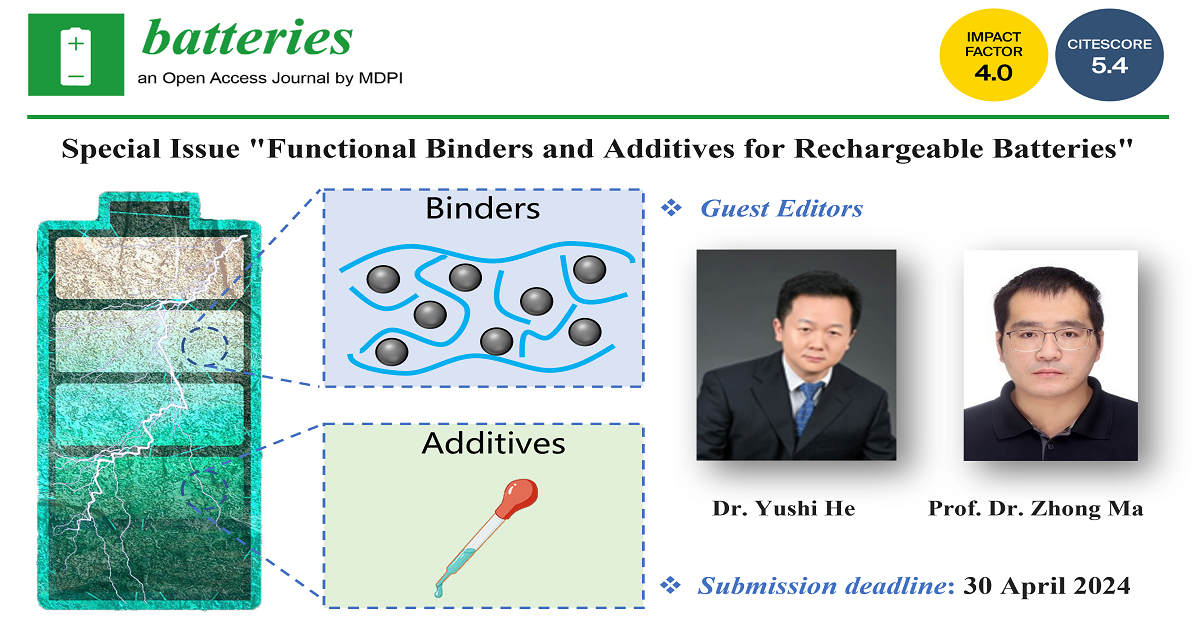Functional Binders and Additives for Rechargeable Batteries
A special issue of Batteries (ISSN 2313-0105). This special issue belongs to the section "Battery Materials and Interfaces: Anode, Cathode, Separators and Electrolytes or Others".
Deadline for manuscript submissions: closed (30 April 2024) | Viewed by 4894

Special Issue Editors
Interests: advanced energy materials (lithium-ion batteries, sodium-ion batteries, air batteries, etc.); advanced biomaterials (bone regeneration, biofilm, scaffold materials, etc.)
Interests: rechargeable batteries; functional binders; electrocatalysis; advanced materials for secondary batteries; electrocatalysts for fuel cells
Special Issue Information
Dear Colleagues,
Rechargeable batteries, such as lithium-ion batteries, are considered as the candidate technologies for several industrial sectors including electric vehicles, consumer electronics, and stationary energy storage. Increasing the energy density and lifespan of rechargeable batteries, which are restricted by their key components, is crucial to their widespread applications. Except for anode and cathode materials, binders and additives are also critical components of rechargeable batteries that significantly affect whole battery performances, despite only accounting for a very small ratio of the entire electrode or electrolyte. Therefore, it is a big interest to explore new functional binders and additives and investigate their roles in rechargeable batteries.
This Special Issue focuses on the progress of functional binders and additives for rechargeable batteries, such as metal-ion batteries, metal batteries, and metal-air/sulfur batteries.
Potential topics include, but are not limited to:
- New binders;
- Mechanical property of binders;
- Cross-linked polymeric networks;
- Additives for low-temperature batteries;
- Additives for high-voltage batteries;
- Additives for electrocatalysis in batteries.
Dr. Yushi He
Prof. Dr. Zhong Ma
Guest Editors
Manuscript Submission Information
Manuscripts should be submitted online at www.mdpi.com by registering and logging in to this website. Once you are registered, click here to go to the submission form. Manuscripts can be submitted until the deadline. All submissions that pass pre-check are peer-reviewed. Accepted papers will be published continuously in the journal (as soon as accepted) and will be listed together on the special issue website. Research articles, review articles as well as short communications are invited. For planned papers, a title and short abstract (about 100 words) can be sent to the Editorial Office for announcement on this website.
Submitted manuscripts should not have been published previously, nor be under consideration for publication elsewhere (except conference proceedings papers). All manuscripts are thoroughly refereed through a single-blind peer-review process. A guide for authors and other relevant information for submission of manuscripts is available on the Instructions for Authors page. Batteries is an international peer-reviewed open access monthly journal published by MDPI.
Please visit the Instructions for Authors page before submitting a manuscript. The Article Processing Charge (APC) for publication in this open access journal is 2700 CHF (Swiss Francs). Submitted papers should be well formatted and use good English. Authors may use MDPI's English editing service prior to publication or during author revisions.
Keywords
- functional binders
- functional additives
- Li/Na/K-ion battery
- Mg/Zn/Ca/Al-ion battery
- metal battery
- metal-S/O2 battery
- aqueous battery
- solid-state battery
Benefits of Publishing in a Special Issue
- Ease of navigation: Grouping papers by topic helps scholars navigate broad scope journals more efficiently.
- Greater discoverability: Special Issues support the reach and impact of scientific research. Articles in Special Issues are more discoverable and cited more frequently.
- Expansion of research network: Special Issues facilitate connections among authors, fostering scientific collaborations.
- External promotion: Articles in Special Issues are often promoted through the journal's social media, increasing their visibility.
- e-Book format: Special Issues with more than 10 articles can be published as dedicated e-books, ensuring wide and rapid dissemination.
Further information on MDPI's Special Issue polices can be found here.






